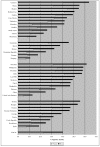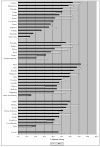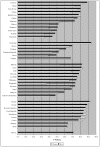The influence of the macro-environment on physical activity: a multilevel analysis of 38 countries worldwide
- PMID: 22967164
- PMCID: PMC3490943
- DOI: 10.1186/1479-5868-9-110
The influence of the macro-environment on physical activity: a multilevel analysis of 38 countries worldwide
Abstract
Background: As indicated by the ANGELO framework and similar models, various environmental factors influence population levels of physical activity (PA). To date attention has focused on the micro-level environment, while evidence on the macro-level environment remains scarce and mostly limited to high-income countries. This study aims to investigate whether environmental factors at macro-level are associated with PA among a broader range of countries.
Methods: Data from the World Health Survey (WHS) was used to analyze 177,035 adults from 38 (mostly low and middle income) countries. The International Physical Activity Questionnaire-Short Form (IPAQ-S) was used to measure PA. Respondents were classified as active or inactive for vigorous PA, moderate PA and walking. Multilevel logistic regression was performed to assess associations between macro-level environmental factors and the prevalence of PA, with control for individual-level socioeconomic factors.
Results: The prevalence of PA varied widely between countries and types of PA (5.0%-93.8%). A negative association was found between gross domestic product and PA, odds ratios for men were 0.76 (95% CI: 0.65-0.89) for moderate PA and 0.79 (95% CI: 0.63-0.98) for walking. A higher temperature was associated with less PA (all types) and higher urbanization was associated with less vigorous and moderate PA. More gender equality was also associated with more walking for women. Governmental functioning and literacy rate were not found to be associated with any type of PA.
Conclusions: This exploratory study indicates that factors such as climate, economic development and cultural factors are determinants of the level of overall PA at national levels. This underlines the suggestion that the macro-environment should be regarded as an important influence on PA.
Figures
Similar articles
-
Perceived environmental correlates of physical activity and walking in African young adults.Am J Health Promot. 2011 May-Jun;25(5):e10-9. doi: 10.4278/ajhp.090918-QUAN-304. Am J Health Promot. 2011. PMID: 21534826
-
Heavy domestic, but not recreational, physical activity is associated with low back pain: Australian Twin low BACK pain (AUTBACK) study.Eur Spine J. 2014 Oct;23(10):2083-9. doi: 10.1007/s00586-014-3258-2. Epub 2014 Mar 12. Eur Spine J. 2014. PMID: 24619607
-
Do country-level environmental factors explain cross-national variation in adolescent physical activity? A multilevel study in 29 European countries.BMC Public Health. 2019 Jun 3;19(1):680. doi: 10.1186/s12889-019-6908-9. BMC Public Health. 2019. PMID: 31159749 Free PMC article.
-
Reliability and validity of the international physical activity questionnaire in the Nord-Trøndelag health study (HUNT) population of men.BMC Med Res Methodol. 2008 Oct 9;8:63. doi: 10.1186/1471-2288-8-63. BMC Med Res Methodol. 2008. PMID: 18844976 Free PMC article.
-
Global physical activity levels: surveillance progress, pitfalls, and prospects.Lancet. 2012 Jul 21;380(9838):247-57. doi: 10.1016/S0140-6736(12)60646-1. Lancet. 2012. PMID: 22818937 Review.
Cited by
-
Level of physical activity among urban adults and the socio-demographic correlates: a population-based cross-sectional study using the global physical activity questionnaire.BMC Public Health. 2019 Aug 22;19(1):1160. doi: 10.1186/s12889-019-7465-y. BMC Public Health. 2019. PMID: 31438909 Free PMC article.
-
Association of physical activity with socio-economic status and chronic disease in older adults in China: cross-sectional findings from the survey of CLASS 2020 after the outbreak of COVID-19.BMC Public Health. 2024 Jan 2;24(1):37. doi: 10.1186/s12889-023-17492-9. BMC Public Health. 2024. PMID: 38166980 Free PMC article.
-
Built environmental correlates of physical activity in China: A review.Prev Med Rep. 2016 Mar 15;3:303-16. doi: 10.1016/j.pmedr.2016.03.007. eCollection 2016 Jun. Prev Med Rep. 2016. PMID: 27419030 Free PMC article. Review.
-
Life in lockdown: a longitudinal study investigating the impact of the UK COVID-19 lockdown measures on lifestyle behaviours and mental health.BMC Public Health. 2022 Aug 5;22(1):1495. doi: 10.1186/s12889-022-13888-1. BMC Public Health. 2022. PMID: 35932040 Free PMC article.
-
Physical Activity and Sedentary Behavior among Young Adolescents in 68 LMICs, and Their Relationships with National Economic Development.Int J Environ Res Public Health. 2020 Oct 23;17(21):7752. doi: 10.3390/ijerph17217752. Int J Environ Res Public Health. 2020. PMID: 33114035 Free PMC article.
References
-
- Bauman AE. Updating the evidence that physical activity is good for health: an epidemiological review 2000-2003. J Sci Med Sport. 2004;7:6–19. - PubMed
-
- Jacoby E, Bull F, Neiman A. Rapid changes in lifestyle make increased physical activity a priority for the Americas. Rev Panam Salud Publica. 2003;14:223–228. - PubMed
MeSH terms
LinkOut - more resources
Full Text Sources
Research Materials




